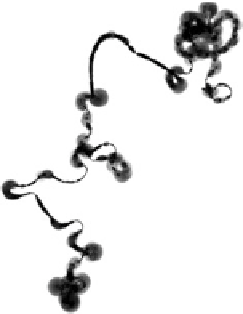Information Technology Reference
In-Depth Information
Fig. 7.5
Example of a
drawing produced with Ze
Frank's reactive v_draw
system
The volume level of sounds
produced by the user is
translated into lines on
screen: quiet noises turn the
line anticlockwise, loud
noises turn the line clockwise
(Fig.
7.6
). Awareness of these and how they might be combined within or across a
generative system is an important step toward a better understanding of the range of
creative relationships that are possible.
A
directed
tool is the classical form of computational application: controlled
through a typical HCI device (mouse, keyboard, touchscreen), these are used to me-
diate creative acts onto a screen or printing device. The user exercises control over
the outcome of their actions, which is produced (effectively) immediately. Typi-
cal examples are desktop applications for graphics, musical composition or word
processing, such as Adobe Photoshop and Sibelius. Such a tool should operate pre-
dictably and readily learnable.
A
reactive
tool senses a user's creative acts, through a microphone, camera
or other sensor, and responds proportionately—often in another sensory domain.
A commonplace example is the real-time visualisation of music, as exemplified by
the likes of Apple's iTunes media player. No expectation is produced for further de-
velopment within the aesthetic narrative, though the user may be able to learn and
master the mode of interaction.
Other examples of reactive tools include Ze Frank's
v_draw
12
web application,
which maps sound volume levels into drawn lines (see Fig.
7.5
). Amit Pitaru's
Sonic
Wire Sculptor
13
performs the same operation in the other direction, transforming
drawn 3-D structures into looping sound.
A
procedural
system involves a fixed process, typically designed by the user,
which unfolds gradually when triggered. Examples include the phasing techniques
used by Steve Reich, Iannis Xenakis' physical simulations of particle clouds, and
the plant growth models of Lindenmayer systems (McCormack
1996
). Though some
indeterminate elements may be present, and a seed configuration may be input by
the user (as in the case of L-systems), no subsequent intervention is required or
expected.


